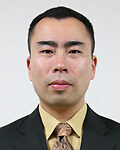Seminar "Breaking the Classical Optical Limit: From Micro- to Nano-spectroscopy and its temporal control" by Dr. Norihiko Hayazawa

Date
Location
Description
Breaking the Classical Optical Limit: From Micro- to Nano-spectroscopy and its temporal control
by Norihiko Hayazawa1,2
1 Surface and Interface Science Laboratory, RIKEN
2 Innovative Photon Manipulation Research Team, RIKEN
ABSTRACT
Despite the Ångstrom spatial resolution achieved by electron microscopes and scanning probe microscopes, optically “seeing” nanoscale objects in the ambient is a limitless demand of human because of its high chemical sensitivity, which has led to the development of near-field optics, and recently, super-resolution optics. On one hand, scientists are still trying to improve the spatial resolution of each technique. On the other hand, it is equally important to develop spectroscopic methods to distinguish different chemical species. While optical spectroscopy method provides various chemical information, the spatial resolution has been very poor due to diffraction limit of light as compared to electron microscopy, SEM and TEM or scanning probe microscopy, AFM, and STM. However, since its inception in the year 2000 [1], tip-enhanced Raman spectroscopy (TERS) has been recognized as one of the promising spectroscopic techniques in nanoscale due to the plasmonic properties of tip-enhancement, which works for both photon confinement and enhancement [2]. From the scientific point of view, lots of efforts have been paid for the improvement of spatial resolution and sensitivity. One of the promising approaches is utilizing nonlinear response of material such as the narrowband coherent anti-Stokes Raman scattering (CARS) [3] and broadband CARS [4]. The other approach recently on trend is the hot spot engineering of gap-mode plasmon based on scanning tunnelling microscopy (STM) based TERS, which achieved up to ~1 nm spatial resolution in ambient [5].
In this talk, I introduce an extremely high spatial resolution down to 1.7 nm in tip-enhanced Raman spectroscopy, which is currently the highest spatial resolution that has been achieved in Raman spectroscopy in ambient [6]. While developing the optical microscope with high spatial resolution, a natural question subsequently arises as to how short excitation is possible with such an extremely high spatial resolution since one of the virtues of optical excitations is its high temporal resolution that is not attainable by any other techniques. We demonstrate a generation of extreme spatio-temporally confined nano-light source exhibiting 10 fs in time [7]. The mechanism is based on degenerated four-wave mixing (FWM) at a sharp metallic tip. I will discuss the potential applications of tip-enhanced Raman and nonlinear Raman spectroscopy and microscopy based on our extreme spatial and temporal resolution.
References
[1] N. Hayazawa, Y. Inouye, Z. Sekkat, S. Kawata, Opt. Commun. 183 (2000), 333–336.
[2] N. Hayazawa, T. Yano, and S. Kawata, J. Raman Spectrosc. 43, 1177 (2012).
[3] T. Ichimura, N. Hayazawa, M. Hashimoto, Y. Inouye, S. Kawata, Phys. Rev. Lett. 92 (2004), 220801.
[4] K. Furusawa, N. Hayazawa, S. Kawata, J. Raman Spectrosc. 41 (2010), 840-847.
[5] C. Chen, N. Hayazawa, S. Kawata, Nat. Commun. 5 (2014), 3312.
[6] https://en.wikipedia.org/wiki/Tip-enhanced_Raman_spectroscopy
[7] K. Furusawa, N. Hayazawa, T. Okamoto, T. Tanaka, and S. Kawata, Opt. Exp. 19, 25328 (2011).
BIOGRAPHY
Dr. Hayazawa obtained Doctor of Engineering from Department of Applied Physics, Osaka University in 2001. After serving as a postdoctoral researcher in Osaka University and RIKEN as a JSPS and JST-CREST researcher, he becomes a tenured institute scientist in RIKEN in 2004 and currently a senior research scientist in RIKEN since 2009. He is also a visiting associate professor in Tokyo Institute of Technology since 2012 and also severed as a visiting scientist in Ecole Polytechnique de Montreal (2012-2016) and National Taiwan Normal University (2014). He got various awards including Near-field Optics Award of Optical Society of Japan (2000), Elsevier Chemical Physics Letters Most Cited Paper Award (2008), The Spectroscopic Society of Japan Award for Young Scientist (2012), The Young Scientists’ Prize from Ministry of Education in Japan (2012), Optics Paper Award of Optical Society of Japan (2013), and The 17th Marubun Research Promotion Foundation Research Incentive Award (2014). His recent research interests include surface and interface science, near-field optics, plasmonics, nonlinear optics, and vibrational spectroscopy.
Subscribe to the OIST Calendar: Right-click to download, then open in your calendar application.



